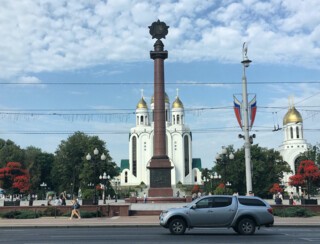Russia’s New War Memorials
Dzmitry Suslau
Having grown up in Minsk I’m used to the sight of Second World War memorials. The total number in Belarus, at a conservative estimate, is about nine thousand. The term ‘Great Patriotic War’ remains in official use in both Belarus and Russia, though no longer in Ukraine where in 2015 it was removed from the national vocabulary.
Visiting Kaliningrad in 2017 to research Russian public art, however, I found Oleg Kopylov’s 2005 Victory Monument bewildering. It’s a Doric column clad in red granite with a bronze relief of St George slaying the dragon on its base. Over the saint’s head is the USSR’s highest military decoration, the Order of Victory – a five-pointed star studded with diamonds, with an image of the Kremlin’s clock tower and Lenin’s mausoleum in the middle. The star also appears, much larger, at the summit of the column. Viewed from across the road, the monument partially obscures the central dome of the Cathedral of Christ the Saviour (also designed by Kopylov), completing the visual amalgam of communism and Christianity.
The bronze relief of St George, Kopylov said, was not part of the original design. An earlier, more ambitious proposal by the sculptor Aleksandr Rukavishnikov was to have four panels depicting scenes from the Seven Years’ War, the Patriotic War of 1812, the First World War and the Great Patriotic War. By representing Russian military glory in Kaliningrad across two centuries, it would have endorsed the fictitious notion of a special historical link between the Baltic exclave (Part of German East Prussia until 1945) and Russia proper. Though the design proved too expensive to realise, the intention was there.
The celebration of military glory throughout history has been enshrined in Russian law since 1995. Though the list of hallowed dates has grown quickly, the victory in the Great Patriotic War remains sacrosanct. Since the early 2000s, a new type of war memorial has emerged across Russia. It commemorates the heroes who fought for the country under both tsarist and Soviet banners. One of the first memorials put up in annexed Crimea was dedicated to the ‘militia of all time’. It depicts, among others, the volunteer fighters of the Crimean War and the so-called ‘Crimean Spring’ – one of the terms used in Russia to describe the 2014 annexation of the peninsula.
Celebrating swathes of ‘national victories’, these memorials, like the column in Kaliningrad, amalgamate Orthodox and Soviet iconography. Since 2015, identical ‘monument-chapels’ emulating traditional sacral architecture have been installed in several Russian cities, including Kaliningrad. Among the inscriptions on these monuments (all of which are in the stylised Old Church Slavonic font), a quotation from Olga Bergholz’s 1959 epitaph for the victims of the Siege of Leningrad stands out: ‘No one is forgotten, nothing is forgotten.’
If such recycling of Christian and Soviet cultural themes seems postmodern at first glance, a closer look suggests an altogether different sensibility, one that celebrates the sacral status of the two pillars of modern Russian nationalism: the Great Patriotic War and the Orthodox faith. The sculptures of military heavyweights installed in Saratov’s Victory Park in 2013 all bear the inscription: ‘Eternal glory to the citizenswho have advanced the glory of Russia’. Even St Aleksandr Nevskii (Oleksandr Nevs′kyi in Ukrainian) has been recast as a model Russian ‘citizen’ alongside Marshal Zhukov. The presentist reinterpretation of history renders them equal in the militant rhetoric of ‘Russia’s unique path’.

Comments